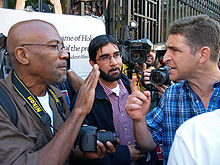Staring
This article has multiple issues. Please help improve it or discuss these issues on the talk page. (Learn how and when to remove these messages)
|

Staring is a prolonged gaze or fixed look. In staring, one subject or person is the continual focus of visual interest, for a long amount of time. The meaning, purpose, and rudeness, of staring varies widely between cultures. Staring can be interpreted as being either hostile like disapproval of another's behavior, or the result of intense concentration, interest or affection. Staring behavior can be considered as a form of aggression like when it is an invasion of an individual's privacy in certain contexts, or as a nonverbal cue to convey feelings of attraction in a social setting.[1] The resultant behavior or action defines whether it is aggressive in nature (e.g. leering that results in street harassment), passive or active expression of attraction, etc. However, to some extent staring often occurs accidentally, and often a person would be simply staring into a space for awareness, or could be lost in thought (sometimes known as daydreaming), stupefied, or be unable to see. As such, the meaning of a person's staring behavior depends upon the attributions made by the observer.[2]
When caught staring, the moment can be a source of embarrassment depending on the reason for staring. For example, in the movie Superbad, the character Fogell is caught staring at a classmate’s exposed thong underwear, or a whale tail. After she turns around, he responds nonsensically by providing an answer to a question that was not asked and promptly walks away from her. Here, Fogell felt embarrassment because he was caught doing something socially unacceptable.[3]

In a staring contest, a mutual staring can take the form of a battle of wills. When eye contact is reciprocated, it could be an aggressive-dominating game where the loser is the person who looks away first.
Staring conceptually also implies confronting the inevitable – 'staring death in the face', or 'staring into the abyss'.[citation needed] Group staring evokes and emphasizes paranoia; such as the archetypal stranger walking into a saloon in a Western to be greeted by the stares of all the regulars. The fear of being stared at is called scopophobia.
Social factors
[edit]
Children have to be socialised into learning acceptable staring behaviour. This is often difficult because children have different sensitivities to self-esteem. Staring is also sometimes used as a technique of flirting with an object of affection. However, being stared at, especially for a prolonged amount of time or very frequently by one person in particular, can cause discomfort to those subjected to it.
Jean-Paul Sartre discusses "The look" in Being and Nothingness, in which the appearance of someone else creates a situation in which a person's subjectivity is transformed without their consent.
Psychological study
[edit]The act of staring implies a visual focus, where the subject of the gaze is objectified. This has been the subject of psychoanalytical studies on the nature of scopophilia, with a subsequent development in some aspects of feminist thought (see film, photography and voyeurism). Paradoxically, the notion of staring also implicates the looker in constructing themselves as a subject. Sartre was interested in the individual experiencing shame only when they perceive that their shameful act is being witnessed by another (see The look).
Staring contests
[edit]
A staring contest is a game in which two people attempt to stare at each other for a longer period of time than their opponent can. The game ends when one participant blinks.
There is a popular variation of the game in which the participants must also not smile, creating a physical as well as a psychological challenge. Most other variations revolve chiefly around either of these two core objectives, with some allowing the aggressive use of distracting actions to force an opponent into defeat, while others prohibit virtually any action but staring.
Another, granted uncommon, and is considered by some unsportsman like, is called the 'ambush' ruleset, where one participant begins the contest without the opponent initially being aware of it. As soon as eye contact is made, the staring contest has begun, and proceeds according to regular conventions. The contest is allowed to pass without the opponent being aware they were involved.
Staring contests ('Stare-out') were featured as an animation in the first series of surreal BBC television comedy sketch show Big Train (aired in 1998). The animation satirised televised sporting events coverage and its over-excited commentary, inspired by events such as the World Chess Championship, cricket, boxing and the football World Cup. The sketches are set during the World Stare-out Championship Finals, a staring match which is described as a global event broadcast all over the world.
In season two, episode four of the Cartoon Network animated sitcom Regular Show, the main villain, "Peeps" (who is a large floating eyeball), is defeated by losing a staring contest.
See also
[edit]References
[edit]- ^ Mary C Townsend; Karyn I Morgan (19 October 2017). Psychiatric Mental Health Nursing: Concepts of Care in Evidence-Based Practice. F.A. Davis. pp. 151+. ISBN 978-0-8036-6986-4.
- ^ Susan T. Fiske (9 November 2009). Social Beings: Core Motives in Social Psychology. John Wiley & Sons. p. 92. ISBN 978-0-470-12911-1.
- ^ Thomson, Desson (1 September 2007). "'Superbad,' Serving The Greater Good". The Washington Post. US: The Washington Post. Retrieved 11 October 2024.

